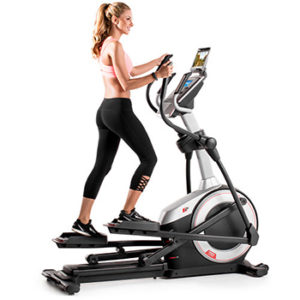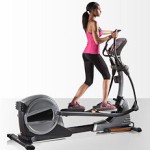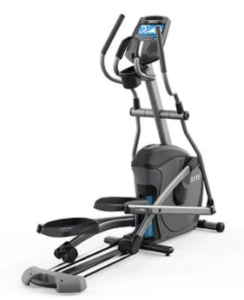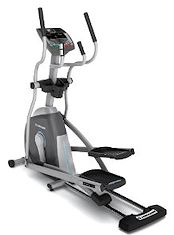
Ellipticals can help you recover from an injury.
You’ve worked so hard to maintain your fitness and work toward a goal. Suddenly your body can’t do what you want it to do. This can be extremely frustrating and discouraging.
But making sure that you are doing everything you can during your recovery is a huge step towards getting back to normal. Ellipticals are a useful tool for runners suffering from a wide variety of injuries. They help you maintain your cardio health, work your muscles and keep you motivated without risk of further injury.
Ellipticals give you a low impact workout option, reducing the risk of strain and impact injuries. Plus, the smooth motion of an elliptical mimics running so you’re still working the same muscle groups that you would pounding the pavement. The track and pedals properly align your body and allow for safe hip and leg extension.

ProForm Endurance 520 E – This is the lowest priced machine you’ll find on our recommended list.
This adds up to a cross-training option that is perfect for runners in rehab. Maintaining fitness levels, strengthening muscles and taking it easy on your joints are all feats that can be tackled on an elliptical. Plus, ellipticals can help you maintain your optimal VO2max.
Team member Rachael shared, “When I was training for my first half marathon, I made the mistake of running too many miles each week. By week 10 of my training plan, I had severe knee pain. I was able to use cross training on an elliptical and exercise bike to maintain my cardio and give my joints a chance to heal before I started back on my running schedule.”
Using an elliptical keeps your joints and muscles moving and working during rehab, but don’t forget that there are other things to do to make sure your recovery is successful.
Foam rollers are a great tool to use during rehab. Using a foam roller gets you many of the benefits of massage, but you can do it on your own without the added expense. Rolling your muscles gets your blood flowing and increases circulation, carrying oxygen rich blood to injured areas. This helps speed your recovery and gets you moving faster.

A foam roller can help your muscles stay loose.
Foam rollers also help stretch your muscles, keeping them from getting stiff and tight during downtime. This aids in flexibility and helps with soreness after any activity or injury.
See this video to learn how to use a foam roller to stretch and massage the muscles that runners use and injure the most.
When you have an injury, simply having something to do makes a huge difference. Mental health during a period of injury is just as important as physical health. Our brains release endorphins when we exercise, which create good feelings in our minds and bodies.
Unfortunately, when those endorphins aren’t being produced, our feelings can swing the other way. As Barbara Walker, Ph.D at the Center for Human Performance says, “if you’re all the sudden injured and can’t work out every day, you’re experiencing a major dip in endorphins.”

NordicTrack SpaceSaver SE7i – Read our full review here.
An injury can disrupt your routine and make you feel isolated, or like you aren’t able to participate in your own life.
This is where maintaining a rehab routine, including elliptical workouts and foam rolling really gets those endorphins flowing again. These tools allow you to set goals, have something to work toward and give you a light at the end of your injury tunnel.
There are a wide variety of elliptical workouts that you can do during rehab and we’ve got you covered for every stage of your recovery!
Warm Up: Start every workout with a 10-min warm-up and finish with a 5-min cool down.
“Easy Workout”
Keep your heart rate between 65-75% and your stride at around 90 RPM for 45-50 minutes. You won’t want an incline for this type of workout, you’re keeping things basic. This workout will be your equivalent to an “easy run” day or recovery day. You’ll maintain your fitness without trying to make any gains.
“Medium Workout”
This is a workout you will want to do on your “maintenance” days. Try and keep your RPM at 90, you aren’t running faster, you’re just exerting more energy. This workout will have you doing intervals and here are a few options to choose from:
Steady Intervals: Work at medium intensity for 3 minutes, recover for 1 minute, then repeat the cycle 5 or 6 times.
Pyramid intervals: Start with a 1-minute medium intensity interval, recover for 2 minutes, then increase the medium intensity intervals in 1-minute increments until you do a 6-minute interval, then work your way back down, finishing with a 1-minute interval.
“Hard Workout”

Horizon Elite E7 – Read our full review here.
These are your “speed days”. Just like running, you won’t want to do more than 2 hard workouts per week. Keep your RPM at 90.
Start yourself a medium resistance for 20 minutes. Then you’ll start your intervals. 3:00 hard, followed by 90 seconds of recovery. Repeat this three times. Finish with a 5 minute cool down.
“Hill Workout” – We all hate hill days, but let’s be honest, they work and it feels great when you finish! Start at a level 1 resistance and maintain your 90 RPM pace. Keep going for 35-40 minutes, increasing the resistance every 4 minutes.
There are a lot of ellipticals out there and it’s important that the one you choose has all of the things you need. Check out some options below that will have you ready to get back out there in no time.
The Horizon Fitness Elite E7 offers an ergonomic design so that you maintain proper body alignment, as well as a 23 lb. flywheel for a super smooth stride. You also have 20 resistance levels to accommodate your workouts, no matter what day it is. Plus, a wireless heart rate strap will let you keep an eye on your heart rate without any distractions.

Horizon EX-59 – Read our full review here.
The Horizon EX-59 is great if you need a smaller stride length that will keep you from extending your hips and legs farther than you should. It also features an ergonomic design and foot pedals to keep you comfortable. The 10 resistance levels and contact grip heart monitors mean you can safely push yourself throughout your recovery. Plus, it’s a great price!
Suffering an injury as a runner may seem like the end of the world, but it doesn’t have to be. Keeping yourself active with elliptical workouts and working your muscles with a foam roller will keep your body going.
This goes hand-in-hand with having a goal and taking the steps to make that happen, which keep your mind going. Keep moving and work through your rehab safely. You’ll be back out there before you know it.